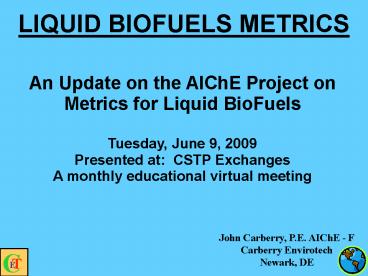LIQUID BIOFUELS METRICS - PowerPoint PPT Presentation
1 / 17
Title:
LIQUID BIOFUELS METRICS
Description:
Any feedstock/conversion technology/fuel combination that could provide at least ... Net renewable energy per acre. Potable water use per nRBtu. ... – PowerPoint PPT presentation
Number of Views:31
Avg rating:3.0/5.0
Title: LIQUID BIOFUELS METRICS
1
LIQUID BIOFUELS METRICS
An Update on the AIChE Project on Metrics for
Liquid BioFuels Tuesday, June 9, 2009 Presented
at CSTP Exchanges A monthly educational virtual
meeting
John Carberry, P.E. AIChE - F Carberry
Envirotech Newark, DE
2
BIOFUELS METRICSObjectives
- Establish science based
- biofuels metrics that
- are broadly accepted
- and widely used.
3
BIOFUELS METRICSGoals
- Recognition, by suppliers of technologies and
feedstocks, for metrics used by government and
industry - Identify the expected users of these metrics
- Identify the expected providers of feedstocks,
technology, or data. - Identify the key US Government functions that
will be impacted by the metrics
4
BIOFUELS METRICSScope
- Define the scope of the study
- 1. boundaries
- 2. impacts
- 3. supply/technology/use chain
- 4. standard vehicle(s)
- 5. most important metrics
- Work with international efforts to the extent
they are compatible with each other.
5
BIOFUELS METRICSBoundaries
- The entire chain from production to use
- Consider only primary metrics
- Liquid bio-fuels for transportation in the US
derived from bio-systems in the US or non-US
bio-systems that could significantly impact US
needs. - Any feedstock/conversion technology/fuel
combination that could provide at least 1 of the
US demand, via technology commercialized within
10 years.
6
BIOFUELS METRICSPrimary (direct) Impacts
- Cost
- Performance
- Net GHG reduction
- Performance as a gasoline (or diesel) alternative
including corrosivity, water solubility, octane
impact, ignition (flash point) performance, etc. - Pollution
- Human and ecological toxicity
- Air
- Aquifers and other potable water supplies
- Surface waters as ecological habitats
- Degradation of soil or habitats
7
BIOFUELS METRICSPrimary (direct) Impacts
- Resource usage (demand)
- Total energy
- Potable water
- Food production displacement
- Production of forest products and other
bio-derived products - Water balance for other ecological needs
- Land for habitats such as wetlands
8
BIOFUELS METRICSComponents of the Use Chain
- Growth
- Harvest and transport
- Conversion to a fuel
- Distribution of the fuel
- Use, primarily as a transportation fuel
9
BIOFUELS METRICSDefining the Standard Vehicle
- We have chosen the pragmatic approach
Royalty free ClipArt
10
BIOFUELS METRICSIn place of the Standard
Vehicle
- Thermodynamic maximum heat will be calculated for
each molecule or mixture - Efficiency of conversion of theoretical heat to
useful energy will be assumed to be the same
among fuels - Likewise (mileage per fuel unit) will be assumed
the same among comparable engines. (e.g. among
diesel fuels) - Corrections will be developed as data warranting
them emerges - Thus all demands will be expressed normalized to
per theoretical net renewable Btu. (nRBtu.)
11
BIOFUELS METRICSQuantitative Continuous Metrics
- Cost per nRBtu.
- Net renewable energy per acre.
- Potable water use per nRBtu.
- Environmental impact on water quality per nRBtu.
- Environmental impact on air quality per nRBtu.
- Food production displaced per nRBtu.
- Adverse impacts on bio-diversity resulting from
changing use of any land or water per nRBtu. - Percent of sustainably available feedstock
required for 10 of the U.S. demand
12
BIOFUELS METRICSQuantitative Conditional Metrics
- Compatibility with co-use of production
facilities by other feedstocks that would have a
different production cycle - Compatibility with present distribution systems
- Compatibility with existing vehicles.
- Impact on rebuilding or depleting the quality and
sustainability of the soil or bodies of water.
13
BIOFUELS METRICSHigh Priority Feedstock and
Fuel Combinations(Technology Options not
Selected)
- Biodiesel from soybeans
- Biodiesel from biomass gasification (FT Rxs)
- Biodiesel from jatropha
- Biodiesel from vegetable oil wastes
- Ethanol from corn
- Ethanol from sugar waste (bagasse)
- Ethanol from switch grass cellulose
- Ethanol from forestry waste cellulose
- Ethanol from corn waste cellulose
- Ethanol from algae
- Liquid fuels from human and animal wastes
- Bio-butanol from something
14
BIOFUELS METRICSThis leads to at least a 144
Box Matrix
- Eight continuous metrics
- Plus four conditional metrics
- By 12 feedstock and fuel combinations
- Or more when technology options are added, plus
other feedstock and/or fuel candidates and issues
as they are uncovered - Presently NOT considering how to develop a
combined score
15
BIOFUELS METRICSPlan for addressing this 72 x
n Box Matrix(One row at a time)
- Review the literature and consult with experts to
develop the best estimate for one row (biodiesel
from soybeans) - Identify the quality, variability and underlying
assumptions of the data - Identify advances (technology, regulatory,
practices) that could significantly improve the
overall metric - Identify resources (experts) to incorporate a
next row on a common basis - Repeat the process for the next row
16
BIOFUELS METRICSPath Forward
- Continue developing rows as we build consensus
on content and perception of value - Recruit additional resources to work on the
rows - Present updated results on a regular basis
(probably, at least at the Spring and Fall
Meetings), to build use and a constituency. - Identify and work with users of the information.
Modify as necessary, based on what we learn and
other feedback
17
Thank you for your time !!!































